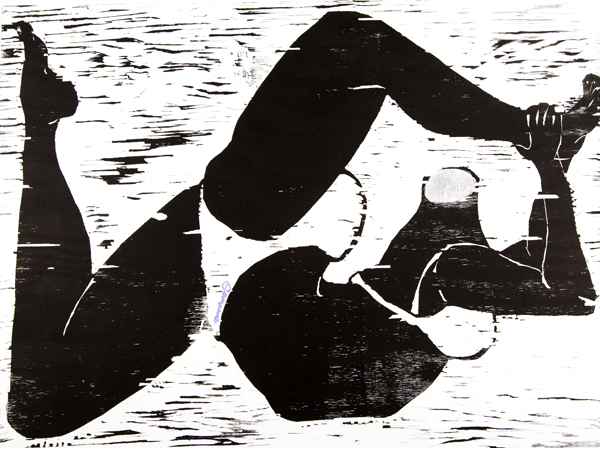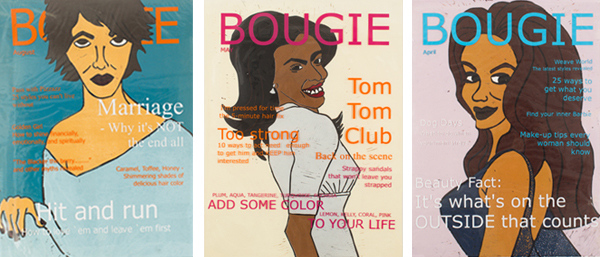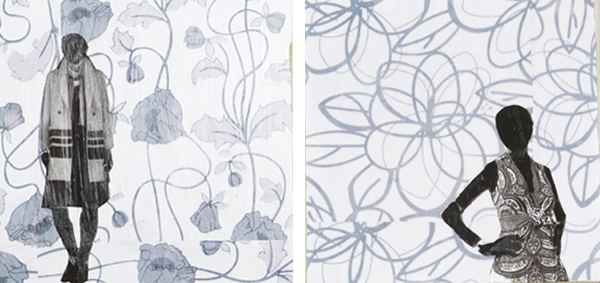By Sally Deskins
Wanda’s work critiques objective representations of the black female body, placing it in contemporary frameworks. Body Map (Wanda Ewing, Body Map, lincout, n.d.) is headless, floating, limited to the square box frame, while strong, sinuous and flexible, in motion. The appealing style in an unknown environment is akin to pop art, but exudes feminist intent—as in the work of Renee Cox and Lorna Simpson.
Wanda played with feminist parody using popular culture fashion magazines and their trite lifestyle advice as a source in her Bougie series, using word play with the strategically posed, curvilinear figures.
Her more subtle Black Catalog series presents collaged and painted black silhouettes created with white models clipped from Anthropologie magazines, placed in grayscale floral atmospheres. Does the viewer see African American figures, or silhouettes of white people? Akin to Kara Walker’s silhouettes recalling traditional African illustration and folklore of the pre-Civil War United States; Wanda’s, too, preserve earlier cultural epochs. While Walker’s images depict violence, Wanda’s appropriation of whiteness critiques standards of beauty, race and perception.
(Wanda Ewing, Black Catalogue, 2009. Each piece: acrylic paint, Xerox, acrylic medium on canvas, 10″ x 10″)
Thanks for reading–my next post will continue the discussion of Wanda’s use of pop art style via her popular pin-up paintings and prints…
______________________________________________________________________________________
Sources
Biga, Leo Adam. “Wanda Ewing Exhibit: Bougie is as Bougie Does,” Leo Adam Biga Blog, 2013.
Bobo, Jacqueline. Black Feminist Cultural Criticism. Oxford: Blackwell Publishers, 2001.
Brand, Peggy Zeglin. “Feminist Art Epistemologies: Understanding Feminist Art,” Hypatia, Vol. 21, No. 3, Summer 2006 (166-189).
Buszek, Maria Elena. Pin-up Grrrls: Feminism, Sexuality, Popular Culture. Duke University Press Books, 2006.
Buszek, Maria. “Wanda Ewing: Self-Identity History: A Retrospective,” exhibition catalog, 2014.
Copeland, Huey. Bound to Appear: Art, Slavery, and the Site of Blackness in Multicultural America. Chicago: University of Chicago Press, 2014.
Fusco, Coco and Brian Wallis. Only Skin Deep: Changing Visions of the American Self. New York: Harry N. Abrams, Inc., Publishers, 2003.
Hutcheon, Linda. Irony’s Edge: The Theory and Politics of Irony. London: Taylor and Francis, 1994.
Gibson, Aliona. Growing up Black and Female in America. Writers and Readers Publishers, 1995.
Lanser, Susan. “The Living Handbook of Narratology.”
Lanser, S. (1986). Toward a Feminist Narratology. Style, 20(3), 341-363.
Maus, Derek. Post-Soul Satire: Black Identity After Civil Rights. University of Mississippi Press, 2014.
McQuiston, Liz. Suffragettes to She Devils. Phaidon Press, 1997.
Silva, Patricia. “Pin-Ups and Wallflowers,” Flare Arts Journal, 2015.
Wright, Beryl J. Lorna Simpson: For the Sake of the Viewer, University Publishing, New York, 1992.


